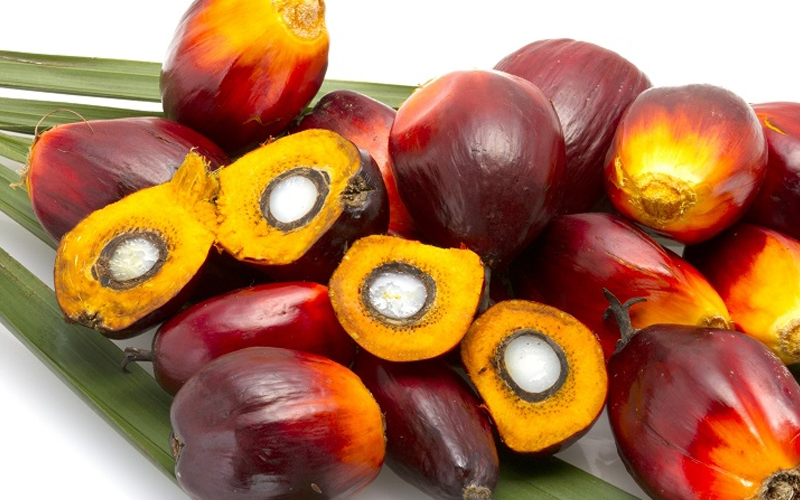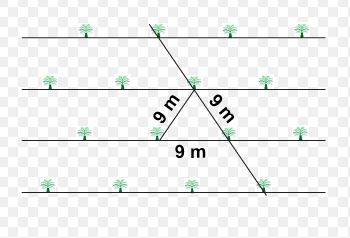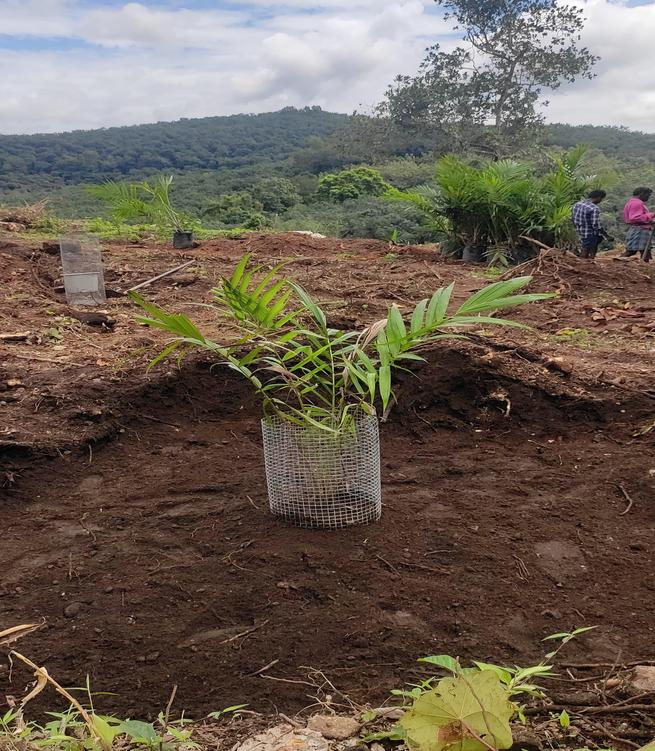Oil Palm Development Programme (OPDP) in India was launched during 1999-2000 under the “Technology Mission on Oil Seeds and Pulses (TMOP) with a focus on area expansion. From 2004-05 onwards the scheme is being implemented as part of the “Integrated Scheme of Oil Seeds, pulses, Oil Palm and Maize (ISOPOM).
A special initiative was undertaken under RKVY during 2011-12 for implementation of special programme on Oil Palm Area Expansion (OPAE) in order to augment the production of Palm Oil. India is one of the major oil seeds grower and importer of edible oils. India’s vegetable oil economy is world’s fourth largest after U.S.A, China and Brazil.
A substantial portion of our requirement of edible oil is met through import of palm oil from Indonesia and Malaysia. India’s foreign currency expenditure towards this is next to petroleum products. Now the scheme is under National Food Security Mission - Oil Palm (NFSM) since 2018
വർദ്ധിച്ചു വരുന്ന ജനപ്പെരുപ്പവും ഉയർന്നു വരുന്ന ജീവിത നിലവാരവും അനുസരിച്ച് ഭക്ഷ്യയെണ്ണയുടെ ഉപയോഗം ഭാരതത്തിൽ ദിനം പ്രതി കൂടിക്കൊണ്ടിരിക്കുന്നു. ഇപ്രകാരം വർദ്ധിച്ചു വരുന്ന ഭക്ഷ്യയെണ്ണ ദൗർലഭ്യം പരിഹരിക്കുന്നതിനുവേണ്ടി ഭാരത സർക്കാർ 1999-2000 കാലയളവിൽ "ടെക്നോളജി മിഷൻ ഓൺ ഓയിൽ പാം ഡെവലപ്പ് മെന്റ് പ്രോഗ്രാമിന് (ഒ.പി.ഡി.പി) തുടക്കം കുറിച്ചു. 2004-05 മുതൽ ഈ പ്രോഗ്രാം "ഇന്റഗ്രേറ്റഡ് സ്കീം ഓഫ് ഓയിൽ സീഡ്സ്, പൾസസ്, ഓയിൽ പാം ആന്റ് മെയ്സ്" (ഐ. എസ്.ഒ.പി.ഒ.എം.) എന്ന പദ്ധതിയുടെ കീഴിലാക്കി. ഭാരതം ലോകത്തിലെ പ്രാധാനപ്പെട്ട ഭക്ഷ്യ എണ്ണയുടെ ഉൽപ്പാദകനും ഇറക്കുമതിക്കാരനുമാണ്. ഇത് ലോകരാജ്യങ്ങളുടെ ഇടയിൽ അമേരിക്കയ്യ്ക്കും, ചൈനയ്ക്കും, ബ്രസീലിനും ശേഷം നാലാമതായി നിൽക്കുന്നു. 2018 മുതൽ ഈ പദ്ധതി നാഷണൽ ഫുഡ് സെക്യൂരിറ്റി മിഷൻ - ഓയിൽ പാം എന്ന് അറിയപ്പെടുന്നു

It is, therefore necessary to exploit domestic resources to maximize production to ensure oil security for the country. Oil Palm is comparatively a new crop in India and is the highest vegetable oil yielding perennial crop. With quality planting materials and proper management there is potential of achieving 20-30 MT Fresh Fruit Bunches (FFBs) per hectare after attaining the age of 5 years. Therefore, there is urgent need to intensify efforts for area expansion under Oil Palm to enhance palm oil production in the country.
Now, National Security Mission (NFSM) envisages increases in production of vegetable oils. In Kerala state, Oil Palm India Limited (OPIL) is the Nodal agency for undertaking area expansion programme of Oil Palm cultivation amongst the small holders in the state. The central and state government are extending subsidy for the cultivation. The programme is successfully implementing in the state with the active participation of the farmers.
Area expansion inputs
Quality of planting materials used greatly determines the productivity and production. It is along with the use of good planting material coupled with proper managemental practices that potential yield level can be achieved. Assistance with be provided to the farmers @ 85% of the cost of planting material limited to `12000/- per ha for entire land holding per planting area of the farmer.
Maintenance cost of new plantation
Oil Palm starts producing Fresh Fruit Bunches (FFBs) after 4 years of its planting. Assistance will be given to the farmers under NMOOP @ 50% of the cost during gestation period for 4 years with a ceiling of `20000/- per ha. Up to 25 ha according to the land ceiling act of respective state governments.
Special features of Oil Palm
- It is a perennial crop that starts yielding from the 4th year of its planting.
- Productivity per ha is more compare to other oil seeds. Under favourable conditions it can yield 4-6 MTs of oil per ha per annum.
- Cost of cultivation is less compare to other oil seeds
- Return from unit area is high compare to other plantation crops.
- It can grow well in almost all types of soil and in varying climatic conditions.
- Inter crops can be cultivated up to 5 years.
- The palm leaf can be used as fodder, an ingredient for organic fertilizers, as fire wood etc.
- Palm oil is rich in vitamin A and Vitamin E.
- Theft is less compare to other cash crops.
- Ability to withstand even in adverse climatic condition.
Oil Palm Cultivation Practices
Oil Palm (Elaeis guineensis), African tree palm, family (Arecaceae) cultivated as a source of oil. Palm oil obtained from the mesocarp of fruit is used as edible oil and in making of soaps, cosmetics, candles, biofuels, lubricating greases and in processing tin plate and coating iron plates. Palm kernel oil, from the seeds, is used in manufacturing edible products such as margarine, ice creams, chocolate confections, cookies and bread as well as many pharmaceuticals. The cake residue after kernel oil extracted is a cattle feed.
The Oil Palm bears a single stem and reaches 20 metres (66 feet) in height. The male and female inflorescences are formed in the same palm. On an average 8-12 bunches can be harvested from a single palm per year.
Soil and climate:
The Oil Palm grows best in areas with a mean maximum temperature of 30-32 0C and on an average of at least five hours of sunlight. Oil palm is humid crop and requires a well distributed rainfall of 200 cm per annum. However, it can tolerate two to four months of dry spell. The adult palms can withstand occasional water logging, but frequent water logged, extremely sandy and hard lateritic soils should be avoided. Best suited soils are moist, well-drained, deep loamy alluvial soils, rich in organic matter with good water permeability. At least one meter depth of soil is required. Avoid highly alkaline, highly saline, waterlogged and sandy soils.
Cultivated variety: Tenera.
Planting:
Best season for planting is June-July ie., during monsoon. In case of planting during summer, adequate irrigation and mulching should be given. 12 to 14 months old healthy seedlings with 1-1.3 m height and 13 functional leaf are recommended for planting. Oil Palm is planted in the main field in triangular system at a spacing of 9 m accommodating 140 palms per ha. The polythene bag is torn open and the entire ball of earth is buried in the pit (50cmx50cmx50cm) and leveled. The planting is done as given in the figure.
Triangular Method of planting

Fertilizer management : Oil Palm is a gross feeder and demands a balanced and adequate supply of macro, secondary and micro nutrients for growth and yield. It is adviced to apply fertilizers at two equal split doses (May & September). The following fertilizer schedule is considered satisfactory for Oil palm
N: P2O5 : K2O (Urea: SSP:MOP)
g/palm/year g/palm/year
First year 400:200:400 (870: 1250:670)
Second year 800:400:800 (1740:2500:1340)
Third Year Onwards 1200:600:1200 (2610:3750:2000)
Mg application is neccesary only if deficiency symptoms are notices. Supply of sufficient quantities of green leaf or compost is advantageous, especially where the soil is poor in organic matter.
Basin cleaning:
During first year, basins of 1m radius, second year 2 m radius and third year 3 m radius are to be taken around the palm by removingthe soils from inside so that the soil will not accumulate at the collar region. Basin area of Oil Palm represents its active root zone. Hence it must be kept clean and weed free to avoid competition for nutrients and water.
Inter-cropping:
Oil Palm is a wide spaced perennial crop with a long juvenile period of 3 years. Inter and intra row space can be used to generate income during the juvenile phase of the crop. Inter crop selected should be compatible with the main crop and should not compete with the main crop for light, water and nutrients. Most suitable crops are vegetables, banana, flowers, chillies, turmeric, ginger, pineapple etc. While growing intercrops in mature Oil Palm gardens of 8- 12 years age or palms attained a height of 3 meters, intercrops should be able to grow under partially shaded conditions and should not compete with Oil Palm for water, sunlight and nutrients ( Eg. Cocoa, pepper, heliconia and ginger lilly).Do not cut the OIl palm fronds or tie the fronds close to the stem for inter-cropping, which will reduce photosynthetic activity. Do not plough close to the plam base, which will cut the absorbing roots and thereby reduce intake of water and nutrients. Maximum number of green leaves should be retained on the palm.
Flowering:
Oil Palm comes to flowering 14-18 months after planting. It produces both male and female flowers separately on the same palm. Male & female phases do occur naturally in consequent cycles in a palm.
Ablation:
Ablation is the removal of male and female flowers produced in the early stages of plantation. This enables the palm to gain adequate stem girth, vigour and develop adequate root system. Start ablation immediately after the appearance of inflorescences on the palms. They can be easily removed by hand or using tool. Ablation can be extended up to 2-1/2 to 3 years depending upon the plant growth and vigour.
Pollination:
Oil Palm is highly cross pollinated crop. Wind and insects assist pollination , but wind pollination is not adequate so assisted pollination is done to ensure fertilization of all female flowers. However, this is not necessary if the pollination weevil Elaedobius kamerunicus is introduced in the plantation. They congregate and multiply on male inflorescence during flower opening. The weevil also visit the female flowers and pollinate them effectively.
Mulching:
Mulching of Oil Palm basin is essential to conserve moiture as well as to control weeds. Mulching can be done with dried leaves, male flowers, coconut husk, empty bunches etc.
Harvesting:
First harvest can be taken 3.5 to 4 years after planting. When a few ripe fruits are loose/ fall off, the bunch is ready for harvesting. Processing over- ripe fruits reduces quantity and quality of oil.Harvesting should be done 10-12 days interval. During rainy season, harvesting should be done at closer interval of 6-7 days as ripening is hastened after hot summer. In young plantations, we get more bunches with less bunch weight and in adult plantations the bunch weight is more but the bunch number is less. From young palms harvesting of bunches are done using a chisel. The stalk of the bunch is struck hard with the chisel to cut off and push the bunch out. When the palms become taller (from 10 year onwards) a harvesting sickle has to be used.
Yield: 4-8 years: 12 t/ha
After 8 years : 20 t/ha.
ഇപ്പോൾ പെട്രോളിയം കഴിഞ്ഞാൽ ഏറ്റവും അധികം വിദേശ നാണ്യം ചെലവഴിച്ച് ഇറക്കുമതി ചെയ്യുന്നത് ഭക്ഷ്യ എണ്ണയാണ്. ഭാരതം എണ്ണ ഇറക്കുമതി ചെയ്യുന്നത് പ്രധാനമായും ഇന്തോനേഷ്യ, മലേഷ്യ തൂങ്ങിയ രാജ്യങ്ങളിൽ നിന്നാണ്. ആയതിനാൽ എണ്ണയുൽപാദനം കൂട്ടുന്നതു ലക്ഷ്യമിട്ടുകൊണ്ട് എണ്ണപ്പന കൃഷിക്ക് പ്രേത്യേക പരിഗണന നൽകികൊണ്ട് ഓയിൽ പാം ഏരിയ എക്സ്പാൻഷൻ (ഒ.പി.എ.ഇ) 2011-12 കാലയളവിൽ നടപ്പിലാക്കി. നിലവിൽ ഈ പ്രോഗ്രാം നാഷണൽ മിഷൻ ഓഫ് ഓയിൽ സീഡ്സ് ആന്റ് ഓയിൽ പാം (എൻ.എം.ഒ.ഒ.പി) പദ്ധതി പ്രകാരം നടപ്പിലാക്കി വരുന്നു.ഇപ്പോൾ പെട്രോളിയം കഴിഞ്ഞാൽ ഏറ്റവും അധികം വിദേശ നാണ്യം ചെലവഴിച്ച് ഇറക്കുമതി ചെയ്യുന്നത് ഭക്ഷ്യ എണ്ണയാണ്. ഭാരതം എണ്ണ ഇറക്കുമതി ചെയ്യുന്നത് പ്രധാനമായും ഇന്തോനേഷ്യ, മലേഷ്യ തൂങ്ങിയ രാജ്യങ്ങളിൽ നിന്നാണ്. ആയതിനാൽ എണ്ണയുൽപാദനം കൂട്ടുന്നതു ലക്ഷ്യമിട്ടുകൊണ്ട് എണ്ണപ്പന കൃഷിക്ക് പ്രേത്യേക പരിഗണന നൽകികൊണ്ട് ഓയിൽ പാം ഏരിയ എക്സ്പാൻഷൻ (ഒ.പി.എ.ഇ) 2011-12 കാലയളവിൽ നടപ്പിലാക്കി. നിലവിൽ ഈ പ്രോഗ്രാം നാഷണൽ ഫുഡ് സെക്യൂരിറ്റി മിഷൻ (NFSM) പദ്ധതി പ്രകാരം നടപ്പിലാക്കി വരുന്നു.ഭാരതത്തെ സംബന്ധിച്ച് എണ്ണപ്പന എന്നത് ഒരു പുതിയ വിളയാണ്. നിലവിലുള്ള എണ്ണക്കുരുക്കളിൽ പ്രേത്യേകിച്ച് ദീർഘകാല വിളകളിൽ ഒരു യൂണിറ്റ് സ്ഥലത്തു നിന്നും ഏറ്റവും കൂടുതൽ എണ്ണ ഉൽപ്പാദിപ്പിക്കാൻ കഴിയുന്ന ഏകവിളയാണിത്. ആനുകൂല്യ സാഹചര്യങ്ങളിൽ ഒരു ഹെക്ടറിൽ നിന്നും 20 മുതൽ 30 വി വരെ എണ്ണപ്പനപ്പഴം "ഫ്രഷ് ഫ്രൂട്ട് ബഞ്ച് " (എഫ്.എഫ്.ബി) ഉൽപ്പാദിക്കാവുന്നതും അതു വഴി 4 മുതൽ 6 വരെ ടൺ ഭക്ഷ്യ എണ്ണ ലഭിക്കുന്നതുമാണ്. കേന്ദ്ര സർക്കാരിന്റെ ഈ പദ്ധതി കേരളത്തിൽ നടപ്പിലാക്കുന്ന നോഡൽ ഏജൻസിയാണ് ഓയിൽ പാം ഇന്ത്യ ലിമിറ്റഡ് (ഒ.പി.ഐ.എൽ).
പദ്ധതി സംബന്ധിച്ച വിവരങ്ങൾ
കൃഷിക്കാവശ്യമായ സങ്കര വർഗത്തിൽപ്പെട്ട ഗുണമേൻമ കൂടിയ നടീൽ വസ്തുക്കൾ സബ്സിഡി നിരക്കിൽ കർഷകർക്കു നൽകുന്നു. തൈകളുടെ വിലയുടെ 85 % സബ്സിഡി, ഹെക്ടർ ഒന്നിന് 12000/- രൂപയായി നിജപ്പെടുത്തി നൽകുന്നു.
എണ്ണപ്പന നാലാം വർഷം മുതൽ ആദായം നൽകി തുടങ്ങുന്നു. പദ്ധതി പ്രകാരം ആദ്യത്തെ നാലു വർഷത്തെ ചിലവിന്റെ 50% സബ്സിഡിയായി അതായത് ഹെക്ടർ ഒന്നിന് 20000/- രൂപയായി നിജപ്പെടുത്തി നൽകുന്നു. ഓരോ സംസ്ഥാനത്തെയും സ്ഥല പരിധി നിയമനുസരിച്ച് 25 ഹെക്ടർ വരെ സ്ഥലത്തേക്കുള്ള കൃഷിക്ക് നിലവിൽ സബ്സിഡി നൽകി വരുന്നു.
എണ്ണപ്പനയുടെ പ്രേത്യേകതകൾ
1. എണ്ണപ്പന നാലാം വർഷം മുതൽ ആദായം നൽകുന്ന ഒരു ദീർഘ കാല വിളയാണ്.
2. മറ്റള്ള എണ്ണക്കുരുക്കളെ അപേക്ഷിച്ച് ഒരു യൂണിറ്റ് സ്ഥലത്തു നിന്നും ഏറ്റവും കൂടുതൽ എണ്ണ ഉൽപ്പാദിപ്പിക്കുന്നു. അനുയോജ്യമായ സാഹചര്യങ്ങളിൽ ഇത് നാലു മുതൽ ആറ് വരെ മെട്രിക് ടൺ എണ്ണ നൽകുന്നു.
3. മറ്റുള്ള എണ്ണക്കുരുക്കളെ അപേക്ഷിച്ച് കുറഞ്ഞ ചിലവിൽ കൃഷി ചെയ്യാം.
4. മറ്റു തോട്ട വിളകളേക്കാൾ കൂടുതൽ ആദായം നൽകും.
5. വൈവിധ്യമായ മണ്ണിലും കാലാവസ്ഥയിലും ഈ വിള കൃഷി ചെയ്യാം.
6. അഞ്ചു വർഷം വരെ ഇതിനുള്ളിൽ ഇടവിള കൃഷി ചെയ്യാം.
7. പനയോല കാലിത്തീറ്റയായും, ജൈവവള നിർമ്മാണത്തിനായും മടൽ തീ കത്തിക്കുന്നതിനായും ഉപയോഗിക്കാം.
8. എണ്ണയിൽ നിന്ന് കിട്ടുന്ന പാം ഓയിൽ വിറ്റാമിൻ A യുടെയും E യുടെയും മുഖ്യ സ്രോതസ്സാണ്.
9. മറ്റു നാണ്യ വിളകളേക്കാൾ മോഷണ ശല്യം കുറവാണ്.
10. എണ്ണപ്പനയ്ക്ക് ഏതൊരു പ്രീതികൂല കാലാവസ്ഥയെയും അതിജീവിക്കാനുള്ള കരുത്തുണ്ട്.
എണ്ണപ്പന
ശാസ്ത്ര നാമം - Elaeis guineensis
കുടുംബം - Arecaceae
ഉത്ഭവം - ആഫ്രിക്കൻ ഭൂഖണ്ഡം
എണ്ണപ്പന പഴത്തിന്റെ തൊണ്ടിൽ നിന്നെടുക്കുന്ന പാമോയിൽ ഭക്ഷ്യ എണ്ണയായും, സോപ്പ്, കോസ്മെറ്റിക്സ്, മെഴുക് എന്നിവയുടെ നിർമ്മാണത്തിനും ജൈവ ഇന്ധനമായും മറ്റും ഉപയോഗിക്കുന്നു. പഴത്തിന്റെ കുരുവിൽ നിന്നെടുക്കുന്ന പാം കെർണൽ ഓയിൽ ഭക്ഷ്യ വസ്തുക്കളായ മാർഗരിൻ, ഐസ്ക്രീം, ചോക്ലേറ്റ്, ബ്രെഡ്, ഔഷധങ്ങൾ എന്നിവയുടെ നിർമ്മാണത്തിനായും ഉപയോഗിക്കുന്നു. കുരുവിൽ നിന്നും എണ്ണ നീക്കിയ ശേഷമുള്ള പിണ്ണാക്ക് കാലിത്തീറ്റയായും ഉപയോഗിക്കുന്നു. എണ്ണപ്പന ഏകദേശം 20 മീറ്ററോളം (60 അടി) ഉയർന്നു വളരുന്ന ഒറ്റത്തടി വൃക്ഷമാണ്. ഈ ചെടിയിൽ ആൺപൂവും പെൺപൂവും പ്രേത്യേകം പ്രേത്യേകമായി ഒരേ ചെടിയിൽ ഉണ്ടാകുന്നു. ഇതിൽ നിന്നും 8 മുതൽ 12 വരെ പങ്കുലകൾ ഒരു വർഷം ഉൽപ്പാദിപ്പിക്കപ്പെടുന്നു.
മണ്ണും കാലാവസ്ഥയും
എണ്ണപ്പന ഒരു ഉഷ്ണമേഖലാ വിളയാണ്. ഒരു വർഷത്തെ വർഷപാതം 200 സെന്റിമീറ്ററും ദിവസം അഞ്ചു മണിക്കൂർ നേരത്തെ സൂര്യപ്രകാശ ലഭ്യതയും 30-32 ഡിഗ്രി സെൽഷ്യസ് താപനിലയും, ഇതിന്റെ ശരിയായ വളർച്ചയ്ക്ക് അഭികാമ്യമാണ്. എന്നിരുന്നാലും മൂന്നു മുതൽ നാലു മാസം വരെയുള്ള വരണ്ട കാലാവസ്ഥയും ഇടേയ്ക്കിടെ ഉണ്ടാകുന്ന വെള്ളക്കെട്ടിനെയും ഇത് അതിജീവിക്കും. നല്ല്ല വളക്കൂറും നീർവാർച്ചയുമുള്ള മണ്ണാണ് ഉത്തമം. ലവണാംശം കൂടിയതും, അമ്ലത കൂടിയതും, മണൽ മാത്രമായതും, വെള്ളക്കെട്ടുള്ളതുമായ സ്ഥലങ്ങൾ ഒഴിവാക്കുക.
കൃഷി ചെയ്യുന്ന ഇനം
ടെനേറ.
തൈ നടീൽ
ജൂൺ, ജൂലൈ മാസങ്ങളാണ് തൈ നടുന്നതിനു അഭികാമ്യം. ഇതിനു മുന്നോടിയായി 50 സെന്റിമീറ്റർ നീളവും, വീതിയും, താഴ്ചയുമുള്ള കുഴികൾ ത്രികോണ മാതൃകയിൽ 9 മീറ്റർ അകലത്തിൽ എടുക്കേണ്ടതാണ്. ത്രികോണ മാതൃകയിലുള്ള കൃഷി രീതി അവലംബിച്ചാൽ ഒരു ഹെക്ടറിന് ഉദ്ദേശം 140 തൈകൾ ഉൾകൊള്ളാൻ കഴിയും. ഈ കുഴികളിൽ മേൽ മണ്ണും 15 കിലോ ചാണകപ്പൊടിയും ഇട്ടു മൂടിയ ശേഷം 12 മുതൽ 14 മാസം വരെ പ്രായമെത്തിയ 13-ഓളം ഇലകൾ വിരിഞ്ഞ തൈകൾ നടാവുന്നതാണ്. തൈകൾ നടുമ്പോൾ 200 ഗ്രാം ഫോസ്ഫേറ്റ് വളവും ചേർത്തു നട്ടാൽ വേരോട്ടം ത്വരിതപ്പെടുന്നതാണ്.
വളപ്രയോഗം
വളപ്രയോഗത്തോട് പ്രീതികരിക്കുന്ന ഒരു വവിളയാണ് എണ്ണപ്പന. മണ്ണു പരിശോധനയ്ക്കു ശേഷം സമീകൃത അനുപാതത്തിൽ വളപ്രേയോഗം നടത്തേണ്ടതാണ്. നമ്മുടെ കാലാവസ്ഥയ്ക്ക് അനുസരിച്ച് പ്രധാനമായും രണ്ടു തവണകളായിട്ടാണ് വളപ്രേയോഗം നടത്തേണ്ടത്. ആദ്യ തവണ മെയ്, ജൂൺ മാസങ്ങളിലും രണ്ടാം തവണ സെപ്റ്റംബർ, ഓക്ടോബർ മാസങ്ങളിൽ ശക്തമായ മഴ ഇല്ലാത്ത ദിവസങ്ങളിലും നടത്താവുന്നതാണ്.
വളത്തിന്റെ അനുപാതം
നൈട്രജൻ : ഫോസ്ഫറസ് : പൊട്ടാസ്യം
ഗ്രാം : പന : വർഷം
ഒന്നാം വർഷം 400 : 200 : 400
രണ്ടാം വർഷം 800 : 400 : 800
മൂന്നാം വർഷം 1200 : 600 : 1200
അതിനു ശേഷം മണ്ണ് പരിശോധനയിൽ മഗ്നീഷ്യത്തിന്റെ കുറവ് കണ്ടാൽ മഗ്നീഷ്യം സൾഫേറ്റ് വളപ്രേയോഗം നടത്തേണ്ടതാണ്. ഇത് കൂടാതെ പച്ചില വളവും, മണ്ണിര കമ്പോസ്റ്റും മറ്റു ജൈവവളങ്ങളും തൈകളുടെ ചുവട്ടിൽ ചേർക്കുന്നത് മണ്ണിന്റെ ഘടനയും ചെടിയുടെ വളർച്ചയ്ക്കും ഉത്തമമാണ്.
ചുവടു തെളിക്കൽ
തൈനട്ട് ഒന്നാം വർഷം തൈയുടെ ചുവട്ടിൽ ഒരു മീറ്റർ ചുറ്റളവിലും, രണ്ടാം വർഷം രണ്ടു മീറ്റർ ചുറ്റളവിലും, മൂന്നാം വർഷം മൂന്നു മീറ്റർ ചുറ്റളവിലും കാടു ചെത്തി മണ്ണിളക്കികൊടുക്കുന്നത് തൈയുടെ വളർച്ചയ്ക്ക് അഭികാമ്യമാണ്.
ഇടവിള കൃഷി
എണ്ണപ്പന അകലത്തിൽ നട്ടു വളർത്തുന്ന ഒരു ദീർഘകാല വിള ആയതിനാൽ ആദായം എടുത്തു തുടങ്ങുന്ന നാലാം വർഷം വരെ ഇടവിള കൃഷി നടത്താവുന്നതാണ്. ഇടവിളയ്ക്ക് അവലംബിക്കാവുന്ന വിളകൾ പ്രധാനമായും പച്ചക്കറികൾ, പുഷ്പകൃഷി,
വാഴ, മുളക്, മഞ്ഞൾ, ഇഞ്ചി, കൈതച്ചക്ക തുടങ്ങിയവയാണ്. എണ്ണപ്പൻതൈകൾ ഉദ്ദേശം മൂന്നു മീറ്റർ ഉയരത്തിൽ വളരുന്നതിന് ശേഷം അതായത് ഉദ്ദേശം 8 വർഷങ്ങൾക്കു ശേഷം തണൽ ഇഷ്ടപ്പെടുന്ന വിളകളായ കൊക്കോ, കുരുമുളക്, ജാതി, ഗ്രാമ്പൂ, ഹെലിക്കോണിയ, എന്നിവ കൃഷി ചെയ്യാവുന്നതാണ്.
ഇടവിള കൃഷി ചെയുമ്പോൾ പനയോലകൾ മുറിക്കുവാനോ ചുവടിനോട് ചേർന്ന് കിളക്കുവാനോ പാടില്ല. അങ്ങനെ ചെയ്യുന്നത് പനയുടെ വളർച്ചയെ ബാധിക്കും.
പൂവ്
തൈകൾ നട്ട് 14 മുതൽ 18 മാസങ്ങൾക്കു ശേഷം പുഷ്പിക്കാൻ തുടങ്ങും. ആൺപൂവും, പെൺപൂവും ഒരു പനയിൽ തന്നെ ചംക്രമണ രീതിയിൽ വന്നുകൊണ്ടിരിക്കും.
അബ്ലേഷൻ
ആദ്യ മൂന്നു വർഷം വരെ ചെടിയിൽ ഉണ്ടാകുന്ന ആൺപൂവും പെൺപൂവും പറിച്ചു മാറ്റേണ്ടതാണ്. ചെടിയുടെ ശരിയായ വളർച്ചയ്ക്ക് ഇത് അത്യന്താപേക്ഷിതമാണ്. ഇങ്ങനെ പറിച്ചു മാറ്റുന്ന പ്രെക്രിയയാണ് അബ്ലേഷൻ ഇത് കൈ കൊണ്ടോ ആയുധം കൊണ്ടോ മാറ്റാവുന്നതാണ്. ഇത് ചെയുമ്പോൾ ഓല നീക്കം ചെയ്യാൻ പാടില്ല.
പരാഗണം
എണ്ണപ്പന ഒരു ക്രോസ്സ് പോളിനേറ്റ് വിളയാണ്. ഒരു ചെടിയിൽ തന്നെ ആൺപൂവും പെൺപൂവും ഉണ്ടാവുകയും, അത് കാറ്റു മൂലമോ, പ്രാണികൾ മൂലമോ പരാഗണം
ചെയ്യപ്പെടുകയും ചെയ്യുന്നു. നിലവിൽ ഈ പ്രക്രിയ ചെയ്യുന്നതിന് ഈ ചെടിയിൽ മാത്രം കാണപ്പെടുന്ന "എലിഡോബിയസ് കാമറൂണിക്കസ് " എന്ന ഒരു വണ്ടിനം ഉണ്ട്.
പുതയിടീൽ
തൈയുടെ ചുവട്ടിലെ ജലസംരക്ഷണത്തിനും കാടു വളർച്ച നിയന്ത്രിക്കുന്നതിനും പനയോലയും ആൺപൂക്കളും മറ്റും ഉപയോഗിക്കാവുന്നതാണ്.
വിളവെടുപ്പ്
ആദ്യ വിളവെടുപ്പ് നാലാം വർഷം തുടങ്ങാം. മൂന്ന് നാലു കായകൾ പഴുത്തു പൊഴിയുമ്പോൾ കുലകൾ വെട്ടാം. 10 മുതൽ 12 വരെ ദിവസത്തെ ഇടവേളകളിൽ കുലവെട്ടാം. വിളവെടുത്ത് 24 മണിക്കൂറിനുള്ളിൽ ഫാക്ടറിയിൽ എത്തിക്കുന്നതാണ്. ഗുണമേൻമയുള്ള എണ്ണ ലഭിക്കാൻ സഹായിക്കും. തൈപ്പനകളിൽ നിന്നും കുലവെട്ടുന്നതിനായി പ്രേത്യേകം വിഭാവനം ചെയ്ത അരിവാളും ഉപയോഗിക്കാവുന്നതാണ്.
ഉൽപ്പാദനം
അനുയോജ്യമായ പരിചരണമുള്ള സ്ഥലത്തു നിന്നും 4 മുതൽ 8 വർഷം വരെ പ്രായമുള്ള പനകൾ 12 MT/ha ഉം 8 വർഷത്തിൽ കൂടുതൽ പ്രായമുള്ള പനകൾ 20 MT/ha പഴവും ലഭിക്കുന്നതാണ്.
Our Brochure - Download Here
Our Notice - Download Here
Application Form - Download Here
Application for Subsidy - Download Here
A Path to Prosperity-NFSM Oil Palm-Oil Palm India Ltd
Expansion of Oil Palm Cultivation 2023-24
As part of the expansion of oil palm cultivation in the financial year 2023-2024 of the National Mission on Edible Oil - Oil Palm Project, oil palm cultivation was started on 2 hectares of land suitable for the cultivation of Jacob and his brothers at Panayath Ponnamthanam House in Erur Panchayat of Kollam district.
നാഷണൽ മിഷൻ ഓൺ എഡിബിൾ ഓയിൽ - ഓയിൽ പാം പദ്ധതിയുടെ 2023-2024 സാമ്പത്തിക വർഷത്തെ എണ്ണപ്പന കൃഷി വ്യാപനത്തിന്റെ ഭാഗമായി കൊല്ലം ജില്ലയിലെ എരൂർ പഞ്ചായത്തിൽ പാണയത്ത് പൊന്നംതാനം വീട്ടിൽ ജേക്കബ് എന്ന കർഷകന്റെയും സഹോദരങ്ങളുടെയും കൃഷിക്കനുയോജ്യമായ 2 ഹെക്ടർ സ്ഥലത്ത് ആരംഭിച്ച എണ്ണപ്പന കൃഷി.



